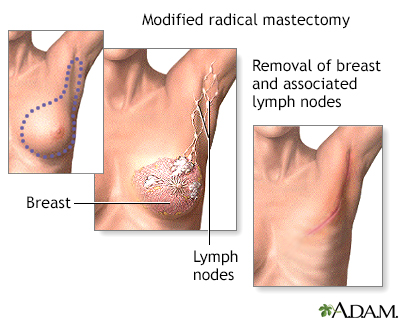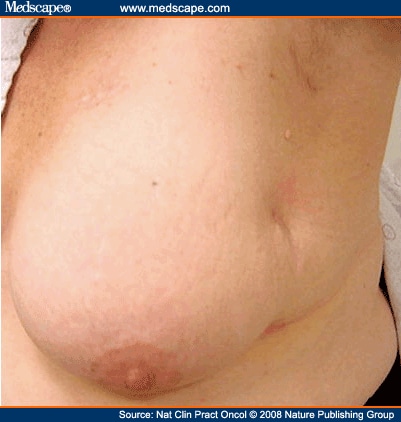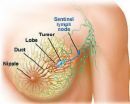A patient generally first goes through a staging process to see if s/he can benefit from local treatment. Staging makes use of clinical, imaging and pathological assessment to make a best guess by the physician. If the cancer has spread beyond the breast and the lymph nodes then it is classified as Stage 4 or metastatic cancer and requires mostly systemic treatment.
Lumpectomy techniques are increasingly utilized for breast-conservation cancer surgery. Studies indicate that for patients with a single tumor smaller than 4cm, lumpectomy may be as effective as a mastectomy. Prior to a lumpectomy, a needle-localization of the lesion with placement of a guidewire may be performed, sometimes by a radiologist if the area being removed was detected by mammography or ultrasound, and sometimes by the surgeon if the lesion can be directly palpated.
Standard practice requires the surgeon to establish that the tissue removed in the operation has margins clear of cancer, indicating that the cancer has been completely excised. If the removed tissue does not have clear margins, further operations to remove more tissue may be necessary. This may sometimes require removal of part of the pectoralis major muscle, which is the main muscle of the anterior chest wall.
During the operation, the lymph nodes in the axilla are also considered for removal. In the past, large axillary operations took out 10 to 40 nodes to establish whether cancer had spread. This had the unfortunate side effect of frequently causing lymphedema of the arm on the same side, as the removal of this many lymph nodes affected lymphatic drainage. More recently, the technique of sentinel lymph node (SLN) dissection has become popular, as it requires the removal of far fewer lymph nodes, resulting in fewer side effects. The sentinel lymph node is the first node that drains the tumor, and subsequent SLN mapping can save 65-70% of patients with breast cancer from having a complete lymph node dissection for what could turn out to be a negative nodal basin. Advances in Sentinel Lymph Node mapping over the past decade have increased the accuracy of detecting Sentinel Lymph Node from 80% using blue dye alone to between 92% and 98% using combined modalities.[dead link] SLN biopsy is indicated for patients with T1 and T2 lesions (<5 cm) and carries a number of recommendations for use on patient subgroups. Recent trends continue to favor less radical axillar node resection even in the presence of some metastases in the sentinel node.
Recently[citation needed] live tissue samples from surgery are tested with various chemotherapy agents to derive probabilities of which ones may work better and specially the ones which would not work (Cell-death assays). The companies need the sample within 24 hours of surgical excision. This is specially useful[citation needed] for early stage cancers were a response for the therapy cannot be determined once the whole cancer is taken out during the surgery and the chemotherapy is given in an adjuciant setting. However, the benefits of such tests have not yet been established in clinical trials and is not mainstream.
Some patients develop lymphedema, as a result of axillary node dissection or of radiation treatment to the lymph nodes. Although traditional recommendations limited exercise, a new study shows that participating in a safe, structured weight-lifting routine can help women with lymphedema take control of their symptoms and reap the many rewards that resistance training has on their overall health as they begin life as a cancer survivor. It recommends that women start with a slowly progressive program, supervised by a certified fitness professional, in order to learn how to do these types of exercises properly. Women with lymphedema should also wear a well-fitting compression garment during all exercise sessions.
Radiation therapy is an adjuvant treatment for most women who have undergone lumpectomy and for some women who have mastectomy surgery. In these cases the purpose of radiation is to reduce the chance that the cancer will recur. Radiation therapy involves using high-energy X-rays or gamma rays that target a tumor or post surgery tumor site. This radiation is very effective in killing cancer cells that may remain after surgery or recur where the tumor was removed. Radiation therapy can be delivered by either external beam radiotherapy or brachytherapy (internal radiotherapy). In the case of external beam radiotherapy, X-rays are delivered from outside the body by a machine called a Linear Accelerator or Linac. In contrast, brachytherapy involves the precise placement of radiation source(s) directly at the treatment site. Radiation therapy for breast cancer is usually performed after surgery and is an integral component of breast-conserving therapy. Radiation therapy eliminates the microscopic cancer cells that may remain near the area where the tumor was surgically removed. The dose of radiation must be strong enough to ensure the elimination of cancer cells. However, radiation affects normal cells and cancer cells alike, causing some damage to the normal tissue around where the tumor was. Healthy tissue can repair itself, while cancer cells do not repair themselves as well as normal cells. For this reason, radiation treatments are given over an extended period, enabling the healthy tissue to heal. Treatments using external beam radiotherapy are typically given over a period of five to seven weeks, performed five days a week. Each treatment takes about 15 minutes. A newer approach, called 'accelerated partial breast irradiaton' (APBI), uses brachytherapy to deliver the radiation in a much shorter period of time. APBI deliveres radiation to only the immediate region surrounding the original tumor and can typically be completed over the course of one week.
Lumpectomy techniques are increasingly utilized for breast-conservation cancer surgery. Studies indicate that for patients with a single tumor smaller than 4cm, lumpectomy may be as effective as a mastectomy. Prior to a lumpectomy, a needle-localization of the lesion with placement of a guidewire may be performed, sometimes by a radiologist if the area being removed was detected by mammography or ultrasound, and sometimes by the surgeon if the lesion can be directly palpated.
Standard practice requires the surgeon to establish that the tissue removed in the operation has margins clear of cancer, indicating that the cancer has been completely excised. If the removed tissue does not have clear margins, further operations to remove more tissue may be necessary. This may sometimes require removal of part of the pectoralis major muscle, which is the main muscle of the anterior chest wall.
 Lumpectomy. Related Breast |  Lumpectomy vs. mastectomy: You |  /x/images/bh/en-gb/lumpectomy- |  In some cases, the cancer is |  partial mastectomy vs |
 Mastectomy is a surgical |  Lumpectomy for Breast Cancer |  Lumpectomy vs Bilateral |  Mastectomy v.s Lumpectomy |  results after lumpectomy |
Some patients develop lymphedema, as a result of axillary node dissection or of radiation treatment to the lymph nodes. Although traditional recommendations limited exercise, a new study shows that participating in a safe, structured weight-lifting routine can help women with lymphedema take control of their symptoms and reap the many rewards that resistance training has on their overall health as they begin life as a cancer survivor. It recommends that women start with a slowly progressive program, supervised by a certified fitness professional, in order to learn how to do these types of exercises properly. Women with lymphedema should also wear a well-fitting compression garment during all exercise sessions.
 Women with breast cancer can |  Mastectomy vs lumpectomy | .jpg) lumpectomy vs mastectomy for |  Lumpectomy Vs Mastectomy |  Simple or total mastectomy |
 A mastectomy was the only |  Typically, lumpectomy does not |  Lumpectomy vs. Mastectomy |  If breast cancer does come |  cardinals-ws-champs-logo |
No comments:
Post a Comment